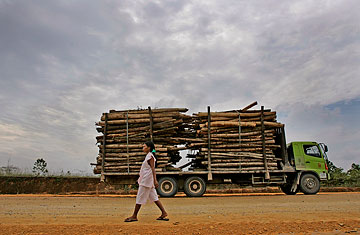
An Indonesian woman walks past a truck carrying acacia logs to be processed at a pulp-and-paper factory in Pangkalan Kerinci, Riau province, Indonesia, on Nov. 1, 2007
On a scorching day in January, the only thing hotter than the afternoon sun is the fiery shouts emanating from the local mosque. Hundreds of villagers have gathered there to speak with the mediation team sent by the government to help settle a dispute between Riau Andalan Pulp & Paper (RAPP) and villagers who want to force the company off Pulau Padang, a small island near Sumatra. "We reject RAPP," a villager screams out to the crowd. "They are thieves that have come to rob our island."
The tensions building in this corner of Riau province are not unusual in today's Indonesia, a country abundant in timber, coal and palm oil. With strong global commodity prices, the drive to exploit these natural resources is greater than ever. But, in many communities, so are calls for resistance. From Pulau Padang and Mesuji in the west to Bima and Timika in eastern Indonesia, anger has often erupted over local and multinational resource-based companies operating in communities who feel their rights are routinely obscured by murky regulations, poor governance and heavy-handed security forces. At the same time companies like RAPP point to the arduous process of obtaining licenses and how this particular concession took five years to negotiate. With so little clarity and so much overlapping authority, it is little wonder that conflict persists.
What stands out in the current battle is the tactics being used to draw attention to the conflict. In December 2011, 28 protesters sewed their mouths shut in front of the parliament building in Jakarta and later threatened to blow themselves up if forcibly removed. In response, on Jan. 3, the Forestry Minister ordered a temporary suspension of RAPP's operations pending the team's nonbinding recommendations on how to resolve the conflict. As the team conducts interviews with villagers, including those believed to be in favor of RAPP operations on the island, a meeting of the minds appears unlikely. "We remain open to dialogue," states Tony Wenas, RAPP's president commissioner.
RAPP, a member of Asia Pacific Resources International Ltd. (APRIL), one of the largest pulp-and-paper producers in the world, was granted a concession of some 41,000 of the island's 110,000 hectares. While the heads of 11 of the island's 14 villages signed an agreement in support of RAPP last year, locals from the three villages against the concession say the company threatens not only their livelihoods as rubber and sago farmers but also the existence of the island itself. "We have worked in and lived off the forests for generations and done fine without RAPP," explains Tame Herman, a member of the Akit tribe who personally opposes the concession although his village, Teluk Belitung, is said to be in favor. "We don't want them or need them, and we are not afraid to die for our land."
Local officials say they will follow whatever order comes from the Forestry Minister, who has the power to revoke the license but does not believe the environmental fears are justified. "People are afraid the island will slowly be eaten away by erosion and then sink," explains Maman Murod, a local forestry official from the Meranti Islands district with jurisdiction over Pulau Padang. "It won't sink." He criticizes the intransigence of the protesters who want the license revoked. "[The company has] done everything by the book," he adds. "They're not here to enrich themselves but also to improve the lives of the people."
Unsurprisingly, that sentiment is shared by RAPP, which directly employs 500 locals and 17 local contracting firms to support its work. "By helping us ... it will benefit them as well," Wenas tells TIME. "They know our presence can make a better living for them." Not everyone agrees, though, particularly since the APRIL conglomerate has been accused of deforesting and polluting other parts of Sumatra, including to the north where its PT Inti Indorayon Utama (now PT Toba Pulp Lestari) faced massive protests in the 1990s. "The situation at Pulau Padang today is very different from Indorayon in the late '90s," Wenas says in response. "The way in which the [current] issues have been dealt with to date has reflected a more measured, matured approach on all sides."
The Indonesian pulp industry is dominated by APRIL and Asia Pulp & Paper, which control 75% of pulp capacity in the country, according to the Center for International Forestry Research's 2008 report on Indonesia's pulp industry. Demand has been increasing dramatically every year and is up 700% since 1990. "Forest loss has been particularly heavy in Riau, which has lost 65% of forest cover in 25 years from pulp, oil palm and other drivers," states the report. "Since late 1980s, Indonesia's pulp industry has been responsible for natural forest clearing of at least 1.7 million hectares."
Indonesian companies are not the only ones dealing with land issues. Foreign firms also cite land problems as a major obstacle to investing in the country, though it appears to be a risk most are willing to take. A whopping $19.28 billion of foreign direct investment poured into the country in 2011, up 18% from the previous year. In that same period, the National Land Agency recorded 2,791 disputes while the National Commission on Human Rights received 4,502 complaints of rights abuses, with 738 stemming from land disputes.
Indonesia's investment czar and Trade Minister, Gita Wirjawan, pointed to the case of South Korea's POSCO group, which invested $6 billion last year despite the prospect of a land dispute in Cilegon, West Java. "They were willing to take a risk before things actually got fixed, but that's the nature of the beast," recounted the minister at a recent event with foreign journalists. "That doesn't mean we don't have to fix things," he added. "We have to show that we enforce rules and regulations properly."
